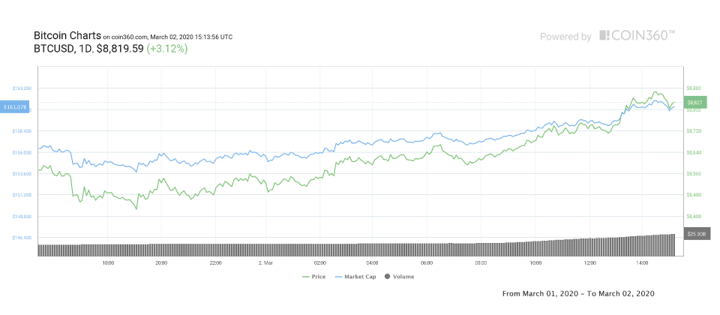Data from Coin360 and Cointelegraph Markets placed the largest cryptocurrency at over $8,800 at press time, slightly down from highs of $8,900 seen earlier.
Daily gains for BTC/USD totaled 3.2%, in line with a rebound in some traditional markets as countries rush to supply financial stimulus packages to boost their economies, Cointelegraph reported.

Bitcoin 1-day price chart. Source: Coin360
While coronavirus continues to spread, it appeared investors were more interested in seeing short-term remedies to limit last week’s heavy losses.
“Reasoning seems to be that, if bad news is good news, then awful news must be fantastic!” market commentator Holger Zschaepitz ironically summarized on Twitter.
Zschaepitz referenced a mainstream media outlet which described the gains as being “built on sand.”
Bitcoin analysts were also tentatively optimistic for the coming days. For Cointelegraph Markets analyst Michaël van de Poppe, a break higher could propel BTC/USD as high as $9,175 before resistance kicks in.
“Still remaining the same on higher timeframes, but we might see a bounce upwards to $9,175 here,” he told Twitter followers on Monday.
“That’s my main level to watch for potential resistance, if market bounces up.”
Press-time levels. meanwhile, roughly correspond to those dictated by bitcoin’s stock-to-flow average prior to the block reward halving in May.
Overall, bitcoin was still down 9.3% on the day versus the beginning of the previous week, while monthly losses totaled a more modest 5.7%.
Beginning on Sunday, the combined cryptocurrency market cap nonetheless added $11 billion, rising to $252 billion as of press time.
Hedge myth
Meanwhile, Michael Novogratz, chief executive of Galaxy Digital, says the popular mantra that bitcoin is a hedge against economic turmoil is a myth. Case in point: Last week, coronavirus fears wiped out $6 trillion from the global markets. Over the same stretch, the dominant cryptocurrency hardly surged. Instead, it dumped from $10,000 to as low as $8,410. The Daily Hodl reported.
Novogratz says the recent joint sell-off of both bitcoin and the equities markets shows that investors are not afraid to pull out of risky investments like cryptocurrency when fear grips the global economy at large.
Such a strategy subjects bitcoin to external factors such as stock market price movement, global economic conditions and geopolitical risks.
Writes Novogratz, “How did BTC go from being a hedge against bad stuff to getting washed out and trading like a risk asset? When things go from bad, to very very bad like they did last week, investors take leverage down as fast as they can. They book profits to make up for other losses. Ouch.”
A study published in the Annals of Operations Research supports Novogratz’s claim. According to Dimitrios Koutmos, an assistant finance professor at Worcester Polytechnic Institute in Massachusetts, interest rates and stock market volatility have an impact on the price of Bitcoin.
He said, “Other asset pricing risk factors, such as interest rates and implied stock market and foreign exchange market volatilities, are important determinants of bitcoin returns.”
However, Welsh crypto YouTuber Louis Thomas was not convinced that the global risk-hedge narrative has been discredited, saying, “I think it is unfair just that because of a few days of the stock market going down and crypto going down that you should make any decisive judgement about that either way.”
























